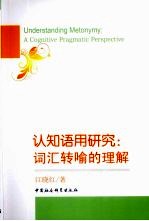
- 作 者:江晓红著
- 出 版 社:北京:中国社会科学出版社
- 出版年份:2009
- ISBN:9787500477020
- 标注页数:201 页
- PDF页数:219 页
请阅读订购服务说明与试读!
订购服务说明
1、本站所有的书默认都是PDF格式,该格式图书只能阅读和打印,不能再次编辑。
2、除分上下册或者多册的情况下,一般PDF页数一定要大于标注页数才建议下单购买。【本资源219 ≥201页】
图书下载及付费说明
1、所有的电子图书为PDF格式,支持电脑、手机、平板等各类电子设备阅读;可以任意拷贝文件到不同的阅读设备里进行阅读。
2、电子图书在提交订单后一般半小时内处理完成,最晚48小时内处理完成。(非工作日购买会延迟)
3、所有的电子图书都是原书直接扫描方式制作而成。
Chapter One Introduction 1
1.1 The importance of metonymy in verbal communication 1
1.2 The target of research 3
1.3 Rationale of the research 8
1.4 Objectives of the study 10
1.5 Methodology for the research 13
1.6 Organization of the dissertation 14
Chapter Two Review of the Relevant Literature 15
2.1 Introduction 15
2.2 Structuralist views 16
2.3 The perspective of cognitive semantics 18
2.3.1 Reference-point phenomena 19
2.3.2 The idealized cognitive model 22
2.3.3 Meaning elaboration 25
2.4 The pragmatic approach 28
2.4.1 Previous pragmatic accounts of metonymy 28
2.4.2 A preliminary relevance-theoretic account of metonymy 31
2.5 The limitations in current accounts of metonymy 35
Chapter Three A Description of the Conceptual Framework 37
3.1 Introduction 37
3.2 The delimitation of metonymy for the present study 37
3.2.1 Linguistic realization of metonymy 37
3.2.2 The working definition of metonymy 42
3.2.3 Distinguishing metonymy from metaphor 45
3.3 Theoretical foundations 48
3.3.1 Relevance theory 49
3.3.2 Cognitive semantics 57
3.3.3 The complementarity of cognitive semantics and relevance theory 64
3.4 The characterization of the conceptual framework 67
3.4.1 Constraints involved in metonymy recognition 67
3.4.2 Comprehension heuristics employed in metonymy interpretation 68
3.4.3 Cognitive effects achieved in metonymy interpretation 69
Chapter Four Constraints on Metonymy Recognition 71
4.1 Introduction 71
4.2 Syntactic constraint:syntactic deviations 72
4.3 Semantic constraint:violations of selection restriction 77
4.4 Cognitive constraint:cognitive principles of relative salience 80
4.4.1 Human experience 81
4.4.2 Perceptual selectivity 83
4.4.3 Cultural preferences 84
4.5 Pragma-cognitive constraint:the constraining influence of context 87
4.5.1 Dynamic context 88
4.5.2 Mutual manifestness 95
4.6 Conclusion 99
Chapter Five Ad hoc Concept Construction of Metonymy 101
5.1 Introduction 101
5.2 Lexical pragmatics and ad hoc concept construction 102
5.3 The "transfers of meaning"issue 105
5.3.1 Reference transfer 106
5.3.2 Contextual variability of word meaning 108
5.4 An alternative solution to"transfers of meaning" 111
5.4.1 Cracking contiguity relations of metonymy 112
5.4.2 A refined relevance-guided comprehension heuristics 121
5.4.3 A cognitive pragmatic interpretation of metonymy:an application 126
5.5 Reference transfer and beyond 135
5.6 Conclusion 140
Chapter Six Cognitive Effects of Metonymy in Utterance Interpretation 142
6.1 Introduction 142
6.2 Economy considerations 143
6.3 Contextual implications 146
6.3.1 A trade-off between cognitive effort and cognitive effects 147
6.3.2 Highlighting of associative relations 150
6.4 Poetic effects 153
6.4.1 Strong and weak implicature 154
6.4.2 Speaking the unspeakable 156
6.4.3 Achieving interpersonal effects 162
6.5 Conclusion 166
Chapter Seven Conclusion 168
7.1 Major findings 168
7.2 Implications 174
7.2.1 Philosophical implications:sense and reference 174
7.2.2 Linguistic implications:semantics-pragmatics distinction 177
7.2.3 Logical implications:ways of inference and utterance interpretation 180
7.3 Suggestions for further study 182
Bibliography 184
后记 199
Lists of Figures and Tables 20
Figure 2-1 Reference-point phenomena 20
Figure 2-2 Metonymy expansion and reduction 27
Figure 2-3 Descriptive and interpretive dimensions of language use 32
Figure 3-1 Continuum view of metaphor and metonymy 48
Figure 3-2 An integrated account of metonymy 70
Figure 5-1 Narrowing 103
Figure 5-2 Broadening 104
Figure 5-3 Reference transfer 108
Figure 5-4 A refined relevance-theoretic comprehension heuristics 123
Figure 5-5 Types of metonymy 135
Figure 5-6 The continuum of"strength of contact" 136
Figure 5-7 Types of partonomy 137
Table 2-1 A general procedure for the comprehension of metonymy 34
Table 5-1 The comprehension heuristic steps involved in metonymy interpretation 129
